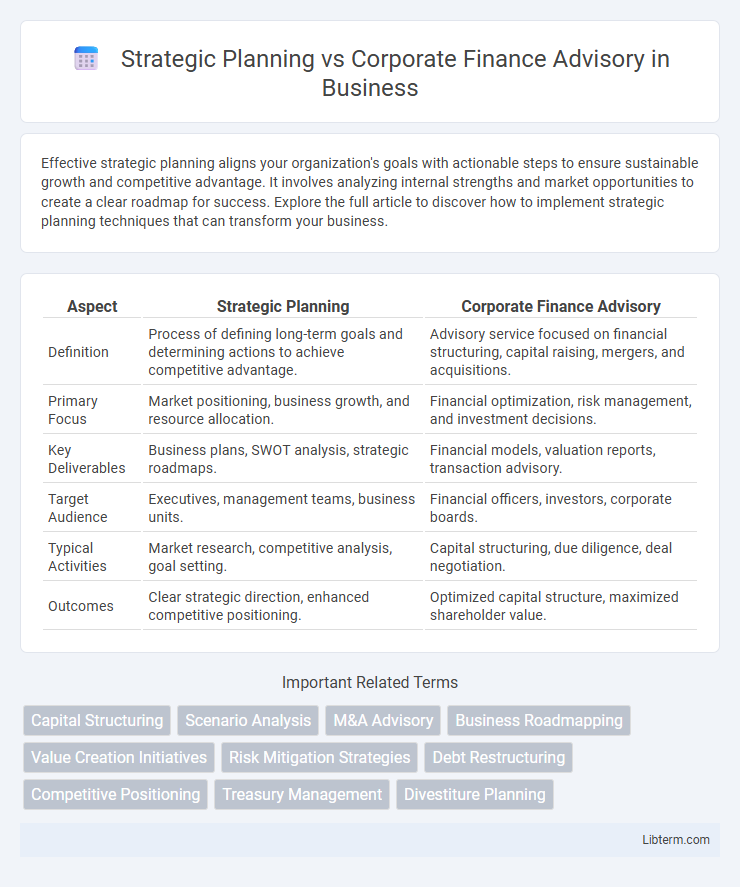Effective strategic planning aligns your organization's goals with actionable steps to ensure sustainable growth and competitive advantage. It involves analyzing internal strengths and market opportunities to create a clear roadmap for success. Explore the full article to discover how to implement strategic planning techniques that can transform your business.
Table of Comparison
| Aspect | Strategic Planning | Corporate Finance Advisory |
|---|---|---|
| Definition | Process of defining long-term goals and determining actions to achieve competitive advantage. | Advisory service focused on financial structuring, capital raising, mergers, and acquisitions. |
| Primary Focus | Market positioning, business growth, and resource allocation. | Financial optimization, risk management, and investment decisions. |
| Key Deliverables | Business plans, SWOT analysis, strategic roadmaps. | Financial models, valuation reports, transaction advisory. |
| Target Audience | Executives, management teams, business units. | Financial officers, investors, corporate boards. |
| Typical Activities | Market research, competitive analysis, goal setting. | Capital structuring, due diligence, deal negotiation. |
| Outcomes | Clear strategic direction, enhanced competitive positioning. | Optimized capital structure, maximized shareholder value. |
Overview: Strategic Planning vs Corporate Finance Advisory
Strategic planning involves developing long-term goals and actionable plans to achieve sustainable business growth, focusing on market positioning, competitive analysis, and resource allocation. Corporate finance advisory centers on financial decision-making, including capital raising, mergers and acquisitions, and optimizing capital structure to enhance shareholder value. Both disciplines drive organizational success but differ as strategic planning emphasizes overarching direction, while corporate finance advisory provides specialized financial solutions.
Core Objectives and Functions
Strategic planning focuses on setting long-term goals, defining business direction, and allocating resources to achieve sustainable growth, while corporate finance advisory centers on optimizing financial structure, managing capital raising, mergers and acquisitions, and risk assessment. Core objectives of strategic planning involve market positioning and competitive advantage, whereas corporate finance advisory aims at maximizing shareholder value and ensuring financial stability. Both functions are critical for organizational success but operate with distinct priorities: strategic planning drives overall vision, corporate finance advisory manages financial execution.
Key Roles and Responsibilities
Strategic planning focuses on setting long-term business goals, analyzing competitive markets, and developing actionable plans to achieve sustainable growth, while corporate finance advisory centers on managing financial assets, advising on mergers and acquisitions, capital structure optimization, and investment strategies. Key roles in strategic planning include market analysis, resource allocation, and performance monitoring to align organizational objectives. Corporate finance advisors handle financial due diligence, risk assessment, and capital raising to enhance shareholder value and ensure fiscal stability.
Approach to Value Creation
Strategic planning emphasizes long-term value creation by setting clear business objectives, analyzing market trends, and aligning resources to achieve sustainable competitive advantage. Corporate finance advisory focuses on maximizing shareholder value through financial structuring, capital allocation, and transaction execution such as mergers and acquisitions. Both approaches complement each other by combining strategic vision with financial expertise to drive growth and optimal resource utilization.
Tools and Methodologies Used
Strategic planning employs tools such as SWOT analysis, PESTEL analysis, and balanced scorecards to assess internal capabilities and external market conditions, enabling organizations to set long-term objectives and allocate resources effectively. Corporate finance advisory utilizes methodologies like discounted cash flow (DCF) analysis, capital structure optimization, and merger and acquisition modeling to maximize shareholder value and guide investment decisions. Both disciplines integrate scenario planning and financial forecasting to align strategic goals with financial performance.
Impact on Organizational Growth
Strategic planning drives organizational growth by aligning long-term goals with market opportunities, enabling proactive resource allocation and competitive positioning. Corporate finance advisory supports growth through capital structure optimization, investment analysis, and financial risk management, ensuring sustainable funding for expansion initiatives. Together, these functions maximize value creation by integrating strategic vision with financial discipline.
Stakeholder Involvement and Decision Making
Strategic planning emphasizes extensive stakeholder involvement to align organizational goals and ensures collaborative decision making across departments and leadership levels. In contrast, corporate finance advisory prioritizes financial stakeholders, leveraging data-driven insights to guide investment decisions and capital structure optimization with a focus on shareholder value. Both disciplines require tailored communication strategies to integrate diverse perspectives while maintaining clarity in decision-making processes.
Time Horizons: Short-term vs Long-term Focus
Strategic planning primarily emphasizes long-term focus, involving setting goals and allocating resources to achieve sustainable growth and competitive advantage over several years. Corporate finance advisory typically concentrates on short-term financial decisions such as capital structure optimization, liquidity management, and immediate investment opportunities to maximize shareholder value. Balancing these time horizons ensures organizations maintain operational stability while pursuing strategic objectives.
Typical Challenges and Pitfalls
Strategic planning often faces challenges such as aligning long-term goals with market dynamics, managing resource constraints, and addressing uncertainty in competitive landscapes. Corporate finance advisory encounters pitfalls including misvaluation of assets, underestimating financial risks, and ineffective capital structure decisions. Both disciplines require rigorous data analysis and scenario planning to mitigate risks and ensure sustainable growth.
Choosing the Right Advisory for Your Business
Strategic planning focuses on setting long-term goals and defining the direction of your business, while corporate finance advisory provides expert guidance on capital raising, mergers, acquisitions, and financial restructuring. Choosing the right advisory depends on whether your business needs growth strategy development or specialized financial transaction support. Evaluating your company's current challenges and objectives ensures alignment with the advisory's expertise for optimal decision-making and value creation.
Strategic Planning Infographic

 libterm.com
libterm.com